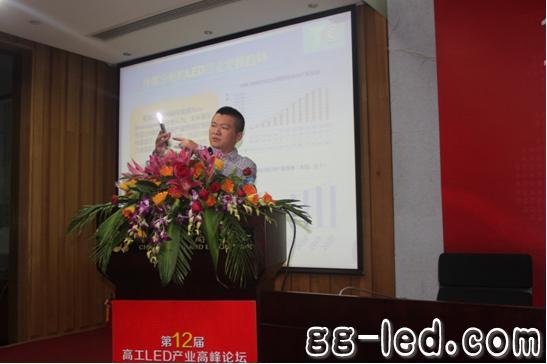On September 27th, from 9:30 to 12:00, the "12th High-tech LED Industry Summit Forum and LED Supply Chain Brand Summit--Package and Lighting Special Agenda" was successfully held in Guangzhou Pazhou Canton Fair. The meeting invited Liu Zhen, general manager of Zhaomingxin Technology, Zou Yiming, general manager of Xinyue Optoelectronics, Wang Mengyuan, general manager of Zhonghao Optoelectronics, Wang Pingjin, chairman of Yingluohua Electronics, Chen Xiangdong, chairman of Silan Microelectronics, and Liu Ronghui, director of Rare Earth Research. Explore the transformation and development of the supply chain in the era of LED lighting market growth.

Liu Zhen: LED flip chip package "big market" approaches <br> <br> flip chip technology (Flip-Chip), also known as "flip chip packaging method", LED industry is currently in a loud voice of a new chip Packaging technology. Due to its high density and high current, it has revolutionized the LED industry.
Liu Zhen, executive director of Zhaomingxin Technology CEO, believes that flip chip technology has become a disruptive product, and its cost advantage and packaged ultra-small investment scale advantages will attract a large number of industries to follow this trend.
Liu Zhen introduced that in the traditional LED flip chip package, in order to increase the area of ​​the light-emitting area, the positive electrode area will be minimized, and the positive and negative electrodes are too close, so that when the circuit is connected, the positive and negative pole positions are not accurately aligned. The high probability will cause the positive and negative electrodes to be short-circuited or open circuited. Therefore, the light-emitting area is inversely proportional to the yield. Although the structure of the flip-chip package is superior to the conventional wire-wrapping method, the market has not been widely used.
In addition, the LED blue-light crystal chip technology represented by the third-generation LED chip technology has been more than ten years old, but its heat dissipation is not good, and the use of gold wire has made the price of LEDs remain high. LED lighting products are difficult to enter the ordinary. The home of the people.
"In order to overcome the technical bottleneck of the third-generation LED chip, after years of research and development, the flip-chip chip represented by the fourth-generation LED chip technology (CSP) has the ability to mass production." Liu Zhen said that it has a suitable height. Current operation, and better heat dissipation characteristics, without the need for gold wires, can be directly soldered to the PCB without the need for packaging and other features will quickly and steadily replace the traditional positive-crystal LED.
"Zhaoming core's fourth-generation flip chip technology has matured and has been mass-produced." Liu Zhen said that the fourth generation of flip chip technology will break through the encirclement of the surrounding city to create countless LED applications in the blue ocean, greatly increasing the market scale. With the prospects.

Fiber optic adapters are typically used to connect two fiber optic cables together. They come in versions to connect single fibers together (simplex), two fibers together (duplex), or sometimes four fibers together (quad). Adapters are designed for multimode or single-mode cables. The single-mode adapters provide more precise alignment of the tips of the connectors and can be used to connect multimode cables. The reverse is not suggested as this might cause misalignment of the small single-mode fibers and loss of signal strength (attenuation).
Optical attenuators are commonly used in fiber-optic communications, either to test power level margins by temporarily adding a calibrated amount of signal loss, or installed permanently to properly match transmitter and receiver levels. Sharp bends stress optic fibers and can cause losses. If a received signal is too strong a temporary fix is to wrap the cable around a pencil until the desired level of attenuation is achieved. However, such arrangements are unreliable, since the stressed fiber tends to break over time.
Types:
Optical attenuators can take a number of different forms and are typically classified as fixed or variable attenuators. What's more, they can be classified as LC, SC, ST, FC, MU, etc. according to the different types of connectors.
Sijee provides different types of Optical Fiber Attenuator, Fiber Optic Attenuator, Fiber Optic Fixed Attenuator, FC Fiber Attenuator.
Fiber Optic Attenuator
Optical Fiber Attenuator,Fiber Optic Attenuator,Fiber Optic Fixed Attenuator,FC Fiber Attenuator
Sijee Optical Communication Technology Co.,Ltd , https://www.sijee-optical.com